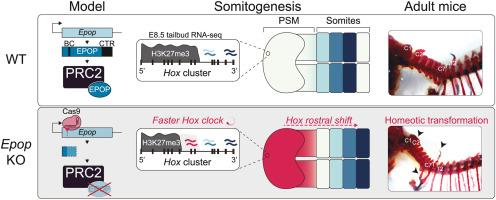prc2相关因子EPOP是小鼠轴向发育过程中Hox基因调控所必需的
IF 2.1
3区 生物学
Q2 DEVELOPMENTAL BIOLOGY
引用次数: 0
摘要
多梳抑制复合体2 (PRC2)是基因抑制的重要调节因子。我们之前报道过,在小鼠胚胎干细胞中,PRC2通过EPOP与伸长蛋白b /C结合,从而允许低水平表达靶基因。在这里,我们通过建立小鼠基因敲除(KO)模型来研究EPOP在体内的作用。我们发现Epop KO小鼠是有活力和可育的,但轴向骨架显示高度渗透的后同源转化,这可以通过只删除母系等位基因部分重现。epop耗尽的胚胎表现出某些Hox基因表达前边界的转移。胚胎的组织特异性RNA测序表明,Hox激活缺陷起源于体前中胚层水平。总的来说,我们发现EPOP可以防止Hox基因子集的过早激活,这是正确的身体前后轴模式所必需的。本文章由计算机程序翻译,如有差异,请以英文原文为准。

The PRC2-associated factor EPOP is required for Hox gene regulation during axial development in mice
The Polycomb repressive complex 2 (PRC2) is an essential modulator of gene repression. We previously reported that, in mouse embryonic stem cells, PRC2 associates with elonginB/C through EPOP, which allows for low-level expression of target genes. Here we investigate the role of EPOP in vivo by generating a mouse knockout (KO) model. We show that Epop KO mice are viable and fertile but display highly penetrant posterior homeotic transformations of the axial skeleton, which can be partially recapitulated by deletion of only the maternal allele. Epop-depleted embryos present a shift of the anterior boundary of expression of certain Hox genes. Tissue-specific RNA sequencing of embryos suggests that the Hox activation defect originates at the level of the presomitic mesoderm. Overall, we find that EPOP prevents premature activation of a subset of Hox genes, and that this is required for correct body patterning along the antero-posterior axis.
求助全文
通过发布文献求助,成功后即可免费获取论文全文。
去求助
来源期刊

Developmental biology
生物-发育生物学
CiteScore
5.30
自引率
3.70%
发文量
182
审稿时长
1.5 months
期刊介绍:
Developmental Biology (DB) publishes original research on mechanisms of development, differentiation, and growth in animals and plants at the molecular, cellular, genetic and evolutionary levels. Areas of particular emphasis include transcriptional control mechanisms, embryonic patterning, cell-cell interactions, growth factors and signal transduction, and regulatory hierarchies in developing plants and animals.
 求助内容:
求助内容: 应助结果提醒方式:
应助结果提醒方式:


